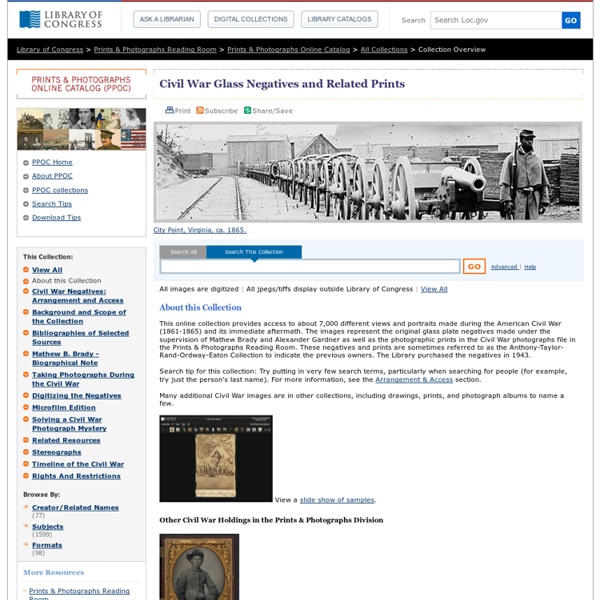To My Old Master
In 1864, after 32 long years in the service of his master, Jourdon Anderson and his wife, Amanda, escaped a life of slavery when Union Army soldiers freed them from the plantation on which they had been working so tirelessly. They grasped the opportunity with vigour, quickly moved to Ohio where Jourdon could find paid work with which to support his growing family, and didn’t look back. Then, a year later, shortly after the end of the Civil War, Jourdon received a desperate letter from Patrick Henry Anderson, the man who used to own him, in which he was asked to return to work on the plantation and rescue his ailing business. Jourdon’s reply to the person who enslaved his family, dictated from his home on August 7th, is everything you could wish for, and quite rightly was subsequently reprinted in numerous newspapers.
Civil War Glass Negatives and Related Prints - Solving a Civil War Photograph Mystery - Prints & Photographs Online Catalog
All images are digitized | All jpegs/tiffs display outside Library of Congress | View All Is this photo fact or fiction? The title information on the bottom left corner of the print says “General Grant at City Point,” so the image claims to show General Ulysses S. Grant on horseback, in front of his troops at City Point, Virginia, during the American Civil War. But, once you look closely at the content of the photo, questions begin to surface.
SAT Subject Test: U.S. History: Toward War
Toward War Abraham Lincoln’s victory in the election of 1860 began a chain of events that pushed the nation rapidly toward civil war. Secession During the 1860 election, some Southerners threatened secession pending Lincoln’s victory, even though he promised that while he would forbid the extension of slavery into the territories, he would not interfere with slavery in the South. In December 1860, soon after Lincoln’s victory, a special South Carolina convention voted unanimously for secession. By February 1861, six more Southern states followed suit: Alabama, Mississippi, Florida, Georgia, Louisiana, and Texas.
U.S. Civil War 1861-1865
Jump To: Fort Sumter Attacked - First Bull Run - Shiloh - Second Bull Run - Antietam - Fredericksburg - Chancellorsville - Gettysburg - Chickamauga - Chattanooga - Cold Harbor - March to the Sea - Lee Surrenders - Lincoln Shot November 6, 1860 - Abraham Lincoln, who had declared "Government cannot endure permanently half slave, half free..." is elected president, the first Republican, receiving 180 of 303 possible electoral votes and 40 percent of the popular vote. December 20, 1860 - South Carolina secedes from the Union. Followed within two months by Mississippi, Florida, Alabama, Georgia, Louisiana and Texas. Auction and Negro sales, Atlanta, Georgia. 1861 February 9, 1861 - The Confederate States of America is formed with Jefferson Davis, a West Point graduate and former U.S. Army officer, as president.
The Battle Over Reconstruction
As the Civil War drew to a close, the social, political and economic conditions within the rebellious southern states fueled discussion about how to restore them to the Union. This series of lesson plans will examine the nature and extent of some of these social, political and economic conditions and how they worked to shape the debate about restoring southern states to the Union as well as their lasting impact in shaping the national debate in the years following Reconstruction. Beyond the obvious material destruction, there was more to reconstruct in the South than buildings, farms, manufacturing and railroads—there were social and political relationships to rebuild. Yet, it is impossible to understand Reconstruction fully without a grasp of the social and economic upheaval the war brought with it.
Women and Freedmen's Aid, DBQ: Part A
This question is based on the accompanying documents (1-8). The question is designed to test your ability to work with historical documents. Some of the documents have been edited for the purposes of this question. As you analyze the documents, take into account both the source of each document and any point of view that may be presented in the document. Historical Context:
Union & Confederate Officer's Jackets
Union After the fall of Fort Sumter, the United States War Department was unable to make enough uniforms fast enough. The northern states were told to dress their own companies.
Lincoln Papers: Lincoln Assassination: Introduction
Abraham Lincoln Papers On the evening of April 14, 1865, while attending a special performance of the comedy, "Our American Cousin," President Abraham Lincoln was shot. Accompanying him at Ford's Theater that night were his wife, Mary Todd Lincoln, a twenty-eight year-old officer named Major Henry R. Rathbone, and Rathbone's fiancee, Clara Harris. After the play was in progress, a figure with a drawn derringer pistol stepped into the presidential box, aimed, and fired. The president slumped forward.



